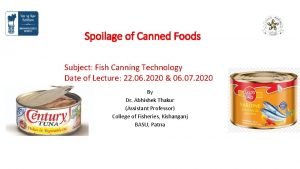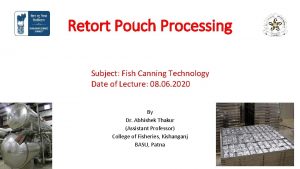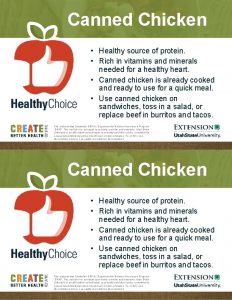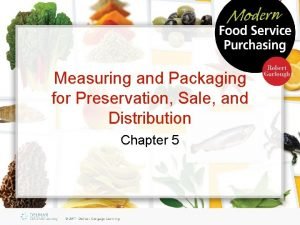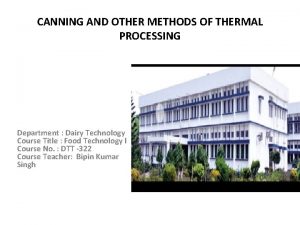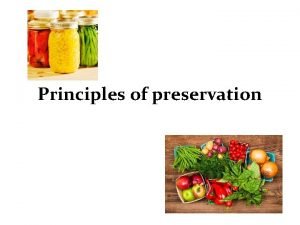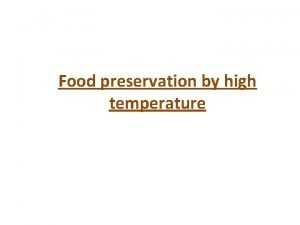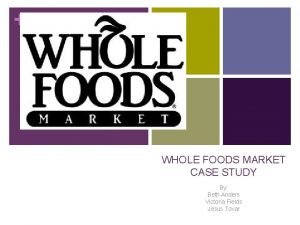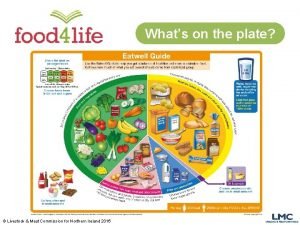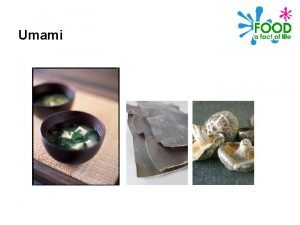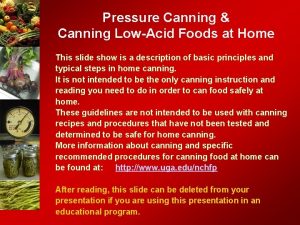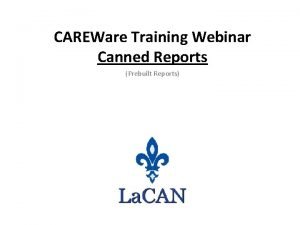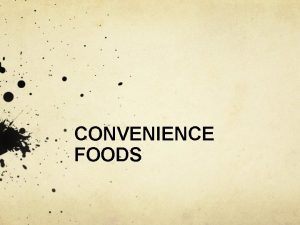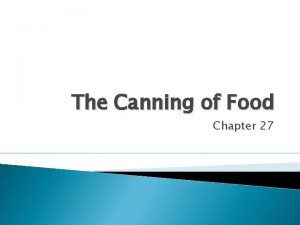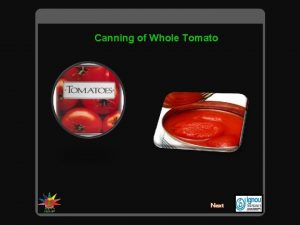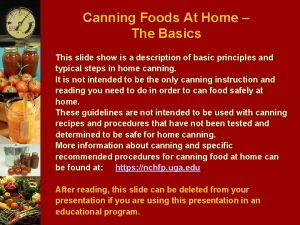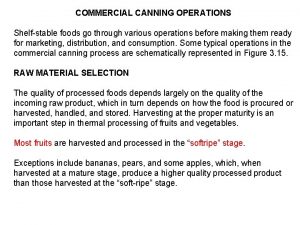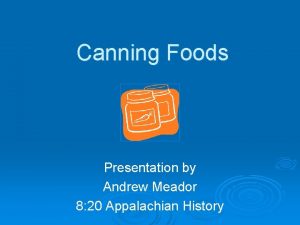CANNED FOODS CANNING Canning is a method of





















- Slides: 21

CANNED FOODS

CANNING Canning is a method of preserving food in which the food contents are processed and sealed in an airtight container. Canning provides a typical shelf life ranging from one to five years, although under specific circumstances a freeze-dried canned product, such as canned, dried lentils, can last as long as 30 years in an edible state To prevent the food from being spoiled a number of methods are used: pasteurisation, boiling (and other applications of high temperature over a period of time), refrigeration, freezing, drying, vacuum treatment, antimicrobial agents are used

SAFE CANNING METHODS The boiling water bath method is safe for tomatoes, fruits, jams, jellies, pickles and other preserves. In this method, jars of food are heated completely covered with boiling water (212°F at sea level) and cooked for a specified amount of time Pressure canning is the only safe method of preserving vegetables, meats, poultry and seafood. Jars of food are placed in 2 to 3 inches of water in a special pressure cooker which is heated to a temperature of at least 240° F.

This temperature can only be reached using the pressure method. A microorganism called Clostridium botulinum is the main reason why pressure processing is necessary. Though the bacterial cells are killed at boiling temperatures, they can form spores that can withstand these temperatures. The spores grow well in low acid foods, in the absence of air, such as in canned low acidic foods like meats and vegetables. When the spores begin to grow, they produce the deadly botulinum toxins(poisons)

Foods that are low acid have a p. H of more than 4. 6 and because of the danger of botulism, they must be prepared in a pressure canner. The low acidic foods include: meats seafood poultry dairy products all vegetables

High acid foods have a p. H of 4. 6 or less and contain enough acid so that the Clostridium botulinum spores can not grow and produce their deadly toxin. High acidic foods can be safely canned using the boiling water bath method. The high acidic foods include: fruits properly pickled vegetables

FACTORS THAT LIMIT THE SHELF LIFE OF CANNED FOODS Cans or glass jars with metal lid can get rusted if not used properly Cans could even corrode, if food will chemically react with metal container. Especially highly-acid food like canned tomatoes and fruit juices gets easily corroded. Temperatures over 100 degrees Fahrenheit are harmful for canned foods. If the storage temperature rises, the risk of spoilage of food, jumps sharply. There are high chances of loosing nutrient of the caned food, if stored at above 75 degree for very long period

SPOILAGE OF CANNED FOODS The most important kind of chemical spoilage of canned foods is hydrogen swell, resulting from the pressure of hydrogen gas released by the action of acid of a food on the iron of the can Hydrogen swells favored by: Ø Increase in acidities of foods Ø Increase in tempratures of storage Ø Imperfections in the tinning and lacquering of the interior of the can Ø Presence of soluble sulphurs and phosphorus compounds

TYPES OF SPOILAGE OF CANNED FOODS Three most important kinds of biological spoilage of commercially canned foods are: Ø flat sour spoilage TA spoilage putrefacation A fourth kind of spoilage caused by the action of food on the iron of the can, results in hydrogen swell Ø Ø Ø

FLAT SOUR SPOILAGE This kind spoilage occurs when canned food remain flat during souring or by development of lactic acid in the food by the flat sour bacteria This spoilage occurs chiefly in low acid foods such as peas and corn and is caused by species of Bacillus Flat sour spoilage of acid foods like tomatoes or tomato juice is caused by special facultatively thermophillic species bacillus coagulans

Various species of bacillus that are able to form acid without gas in food may be mesophilies, facultative thermophilies or obligate thermophilies The spores of mesophilies are less heat resistant and killed by heating process and hence are rarely concerned with flat sour spoilage the spores of thermophilies are more heat resistant and may survive the heat process and cause flat sour spoilage

TA SPOILAGE This is a thermophillic spore forming anaerobe that forms acid and gas in foods The gas(mixture of carbon dioxide and hydrogen) swell the can if it is held long enough at a high temprature and may eventually cause bursting The spoiled food usually has a sour odour. Sources are same as for flat sources bacteria

SULFIDE OR SULFUR STINKER SPOILAGE Spoilage caused by Desulfotomaculum nigrificans Found in low acidic foods such as peas and corn Spores of this bacterium are less heat resistant than those of flat sour and TA bacteria The organism is an obligate thermophile and therefore also requires poor cooling of heat processed foods or hot storage for its development

TYPES OF SPOILAGE BY MESOPHILIC SPORE FORMING BACTERIA MOST SPOILAGE BY MESOPHLIC MICROORGANISMS THAT RESULTS FROM UNDERPROCESSING IS CAUSED BY SPORE FORMING BACTERIA OF THE GENERA BACILLUS AND CLOSTRIDIUM

SPOILAGE BY MESOPHILIC clostridium species: Sugar fermenting species of clostridium –egc. butyricum and c. pasteurianum causes butyric acid fermentation in acidic foods by release of carbon dioxide and hydrogen Other species such as C. sporogenes, C. putrefaciens, C. botulinum are proteolytic or putrefactive decomposing proteins with the production of malodorous compounds such as hydrogen sulfide, ammonia, indole and skatole

Putrefacative anaerobes also produce carbon dioxide and hydrogen, causing the can to swell Canned acid foods such as pineapple, tomatoes and pears have been found spoiled by C. pasteurianum Putrefactive anerobes grow best in the low acid – canned foods such as peas, corn, meat, fish and poultry

SPOILAGE BY MESOPHILLIC bacillus SPECIES: Spores of various species of Bacillus differ considerably in their heat resistance Spores of many of the mesophillies are killed in a short time 100 C` or less but few can survive the heat treatments employed in steam-pressure processing Many species of Bacillus are aerobic and therefore cannot grow in a well evacuated container

Commercially canned foods have been spoiled by bacillus species, especially in poor evacuated cans aerobacilli or gas forming bacillus species have been reported to cause spoilage of canned peas, asparagus, spinach, peaches and tomatoes

SPOILAGE BY YEAST Canned fruits, jams , jellies, fruit juices , syrups and sweetened condesed milk have been spoiled by fermentative yeast with swelling of the cans by carbon dioxide produced Film yeast may grow on the surface of jellied pickled pork, repacked pickles or olives and similar products but their presence indicates contamination or lack of heat processing , plus poor evacuation

SPOILAGE BY MOLDS Molds probably are the most common cause of the spoilage of home canned foods which they enter through a leak in the seal of the container Jams , jellies, marmalades and fruit butters permit mold growth when sugar concentration are as high as 70 % and in the acidity usually present in these products Some molds are fairly resistant to heat, especially those forming tightly packed masses of mycelium called sclerotia. Byssochlamys fulva a pectin fermenting mold, has ascospores that have resisted the heat processing of bottled and canned fruits and have caused spoilage

SPOILAGE OF CANNED MEAT AND FISH Ø Ø Canned fish and meat exhibits two chief types of spoilage by: bacillus species resulting in softening and souring Clostridium species producing putrid swells Less commonly bacilli may produced acid and gas and swells the cans Heat process given to Canned cured meats are insufficient for sterilization therefore it may be subjected to production of carbon dioxide, nitrogen oxide or nitrogen gas from nitrate, sugars and meat or they may subjected to putrefacation with gas produced by Clostridium species Such species ordinarily is prevented by adequate refrigeration
 Spoilage of canned fish
Spoilage of canned fish Tujuan pengembangan sistem informasi akuntansi
Tujuan pengembangan sistem informasi akuntansi Programmed sales presentation
Programmed sales presentation Benjamin west contribute a great deal to american art
Benjamin west contribute a great deal to american art Market form of meat preserved by chemical process
Market form of meat preserved by chemical process Canned cycle
Canned cycle Canned sales presentation
Canned sales presentation Retort pouch canning
Retort pouch canning Canned chicken healthy
Canned chicken healthy Canned queries
Canned queries Purecloud training
Purecloud training Advantages of canning
Advantages of canning Lacquering in canning
Lacquering in canning Heat preservation methods
Heat preservation methods High temperature preservation of food
High temperature preservation of food San simon canning
San simon canning Advantages of symposium
Advantages of symposium Swot analysis whole foods
Swot analysis whole foods Beth anders
Beth anders Kirklees bin collection dates
Kirklees bin collection dates Www.foodfactoflife.org.uk
Www.foodfactoflife.org.uk Foods with umami flavor
Foods with umami flavor
